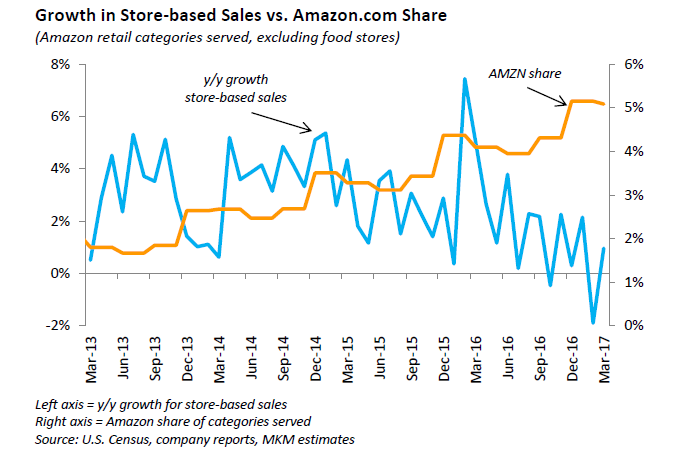One simple chart depicts what’s taking place in retail today, as many traditional players that once boasted impressive revenue growth now report slipping sales.
Amazon, essentially, is “eating the retail world,” MKM Partners analyst Rob Sanderson wrote in a Friday note to clients. His chart shows Amazon, in the categories that the company serves, growing its market share, as brick-and-mortar retail sales are on the decline.
The widening gap over the past year between Amazon and so-called store-based retailers is particularly striking.
SEE ALSO: Amazon prepares to take on South Korean e-commerce
It’s important to note that Amazon still only boasts a 5 percent share of total retail sales, excluding food, across the country, according to data from the U.S. Census Bureau, Sanderson said.

But this is coupled with big names in the retail space — Wal-Mart, Costco, Home Depot, Target — seen as losing market share as their margins shrink and dollars shift back to Jeff Bezos’ company, the analyst added.
The median growth for what MKM Partners calls the top-20 U.S. retailers was 2.4 percent in the fourth quarter of 2016, 0.8 percent during the first quarter of 2017, and is forecast to decline by 0.2 percent in the second quarter this year, the firm said.
Bottom line: Amazon is the “best long-term growth story available to investors today,” Sanderson said.
SEE ALSO: Amazon Web Services to open Hong Kong infrastructure region
And Amazon’s share of retail sales across the U.S. in key categories — sporting goods, clothing, personal care and electronics — will only continue to accelerate from here, he said.
The latest hike in Amazon’s share price is “becoming large enough to make an impact,” Sanderson wrote. “This [trend] does not end well for traditional retailers and many will go the way of Borders and Circuit City, leaders in the first two large categories disrupted by Amazon.com.”
Electronics retailer Circuit City filed for bankruptcy protection in 2008, with book store Borders following suit in 2011.
Amazon’s stock, meanwhile, finally broke the much-anticipated $1,000 per-share mark in late May, beating Alphabet in an unofficial race between the two tech giants. Amazon shares have pared those gains since, closing Thursday at $965.14 piece.
SEE ALSO: Amazon’s grocery push playing catch up with Chinese e-commerce giants
A representative from Amazon did not immediately respond to CNBC’s request for comment.
With an Amazon-Whole Foods deal in the making, pressure is about to hit traditional grocers head-on, as an internet giant takes on the “high-frequency” fresh foods market, MKM Partners added. “[P]ressures on traditional retailers will only get worse.”
As of Thursday’s close, Amazon’s stock has gained 31 percent over the past 12 months, and shares are up about 29 percent in 2017.
(Source: CNBC)




